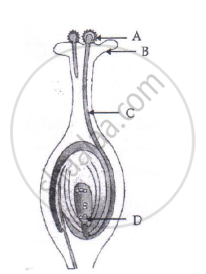Advertisements
Advertisements
प्रश्न
Give scientific reason.
Flower is a structural unit of sexual reproduction in plants.
उत्तर
Flower is structural unit of sexual reproduction in plants. It consists of four floral whorls as calyx, corolla, androecium and gynoecium; arranged in sequence from outside to inside. Androecium and gynoecium are called 'essential whorls' because they perform the function of reproduction whereas calyx and corolla are called as 'accessory whorls' because they are responsible for protection of inner whorls.
संबंधित प्रश्न
Match the following:
| Column A | Column B |
| (i) Stigma | (a) Neuron |
| (ii) Pepsin | (b) Carpel |
| (iii) Dendrites | (c) Protein |
| (d) Stamen |

(i) Name the part marked 'A' in the diagram.
(ii) How dose 'A' reachese part 'B'?
(iii) State the importance of the part 'C'.
(iv) What happens to the part marked 'D' after fertilisation is over?
Answer the following question.
State significance of pollination.
Give one example of a unisexual flower.
How is the process of pollination different from fertilization?
The anther contains ______.
The process of fusion of the male and female gametes is called ______.
Where are the pollen grains produced?
Where are a plant's sex organs located?
What are the reproductive organs in a flower?
Where is the female gamete formed in flowering plants?
Fill in the following blank with suitable word :
Pollen grains contain ............ gametes of a plant.
What is made in ovary of a flower?
How do the insects help in cross-pollination?
Explain the term 'fertilisation'.
Name the part of a seed which grows into root.
In tobacco plant, the male gametes have 24 chromosomes.
What is the number of chromosomes in the female gamete?
(a) Draw a neat diagram of a flower showing its various parts. In this diagram mark stem, receptacle, sepals, petals, stamen and carpel.
(b) What name is given to (i) all the petals of a flower, and (ii) all the sepals of a flower?
(c) What are (i) stamen, and (ii) carpel, in a flower?
(d) What is the other name of carpel of a flower?
(e) What is the name of yellow powdery substance present in the anther of a flower?
Which of the following statements are true for flowers?
(i) Flowers are always bisexual.
(ii) They contain sexual reproductive organs.
(iii) They are produced in all groups of plants.
(iv) after fertilization they give rise to fruits.
Fill in the blanks:
A carpel consists of ________ , ________ and ________.
Mention the function of Stigma.
A student is asked to study the different parts of an embryo of pea seeds. Given below are the essential steps for the experiment :
(I) Soak the pea seeds in plain water and keep them overnight.
(II) Cut open the soaked seed and observe its different parts.
(III) Take some pea seeds in a petri dish.
(IV) Drain the excess water. Cover the seeds with a wet cotton cloth and leave them as it is for a day.
The correct sequence of these steps is
(A) III, I, IV, II
(B) III, IV, I, II
(C) III, I, II, IV
(D) III, II, I, IV
Draw a diagram of the longitudinal section of a flower and label on it sepal, petal, ovary and stigma.
Prepare a slogan for campaign against female foeticide.
Fill in the blank by selecting suitable word:
Transfer of pollen grains from the anther to the stigma is known as______________.
Answer the following question.
List two agents of pollination?
Pollen tube reaches the embryo sac via style.
Observe the figure below. Write functions of the labelled parts.

The 3-celled egg apparatus at the micropylar end comprises of ______
The flower of the Hibiscus plant is ______
Double fertilization is essential for formation of ______.
In a plant flower the female whorl is ______.
Type of sexual reproduction is ______.
The pollen tube usually enters the embryo sac ______.
Explain the post fertilization changes that occur in the ovary of a flower.
